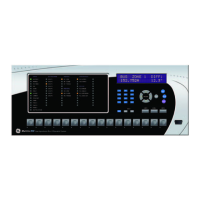5-128 B90 LOW IMPEDANCE BUS DIFFERENTIAL SYSTEM – INSTRUCTION MANUAL
PRODUCT SETUP CHAPTER 5: SETTINGS
5
Configure the operand to drive an output contact, user-programmable LED, or selected communication-based output.
Latching and acknowledging conditions—if required—are programmed accordingly.
The CRC alarm function is available on a per-channel basis. The total number of direct input and output messages that
failed the CRC check is available as the
ACTUAL VALUES STATUS DIRECT INPUTS CRC FAIL COUNT CH1 actual value.
• Message count and length of the monitoring window — To monitor communications integrity, the relay sends 1
message per second (at 64 kbps) or 2 messages per second (128 kbps) even if there is no change in the direct outputs.
For example, setting the
CRC ALARM CH1 MESSAGE COUNT to “10000,” corresponds a time window of about 160 minutes
at 64 kbps and 80 minutes at 128 kbps. If the messages are sent faster as a result of direct outputs activity, the
monitoring time interval shortens. Take this into account when determining the
CRC ALARM CH1 MESSAGE COUNT
setting. For example, if the requirement is a maximum monitoring time interval of 10 minutes at 64 kbps, then the
CRC
ALARM CH1 MESSAGE COUNT
is set to 10 × 60 × 1 = 600.
• Correlation of failed CRC and bit error rate (BER) — The CRC check can fail if one or more bits in a packet are
corrupted. Therefore, an exact correlation between the CRC fail rate and the BER is not possible. Under certain
assumptions an approximation can be made as follows. A direct input and output packet containing 20 bytes results
in 160 bits of data being sent and therefore, a transmission of 63 packets is equivalent to 10,000 bits. A BER of 10
–4
implies 1 bit error for every 10000 bits sent or received. Assuming the best case of only 1 bit error in a failed packet,
having 1 failed packet for every 63 received is about equal to a BER of 10
–4
.
5.3.17.3 Unreturned messages alarm CH1(2)
SETTINGS PRODUCT SETUP DIRECT I/O UNRETURNED MESSAGES ALARM CH1(2)
The B90 checks integrity of the direct input and output communication ring by counting unreturned messages. In the ring
configuration, all messages originating at a given device should return within a pre-defined period of time. The unreturned
messages alarm function is available for monitoring the integrity of the communication ring by tracking the rate of
unreturned messages. This function counts all the outgoing messages and a separate counter adds the messages have
failed to return. When the unreturned messages counter reaches the user-definable level specified by the
UNRET MSGS
ALARM CH1 THRESHOLD
setting and within the user-defined message count UNRET MSGS ALARM CH1 COUNT, the DIR IO CH1
UNRET ALM FlexLogic operand is set.
When the total message counter reaches the user-defined maximum specified by the
UNRET MSGS ALARM CH1 MESSAGE
COUNT
setting, both the counters reset and the monitoring process is restarted.
Configure the operand to drive an output contact, user-programmable LED, or selected communication-based output.
Latching and acknowledging conditions, if required, are programmed accordingly.
The unreturned messages alarm function is available on a per-channel basis and is active only in the ring configuration.
The total number of unreturned input and output messages is available as the
ACTUAL VALUES STATUS DIRECT INPUTS
UNRETURNED MSG COUNT CH1
actual value.
5.3.18 Installation
SETTINGS PRODUCT SETUP INSTALLATION
UNRETURNED
MESSAGES ALARM CH1
UNRET MSGS ALARM CH1
FUNCTION: Disabled
Range: Enabled, Disabled
UNRET MSGS ALARM CH1
MESSAGE COUNT: 600
Range: 100 to 10000 in steps of 1
UNRET MSGS ALARM CH1
THRESHOLD: 10
Range: 1 to 1000 in steps of 1
UNRET MSGS ALARM CH1
EVENTS: Disabled
Range: Enabled, Disabled
INSTALLATION
RELAY SETTINGS:
Not Programmed
Range: Not Programmed, Programmed
RELAY NAME:
Relay-1
Range: up to 20 alphanumeric characters

